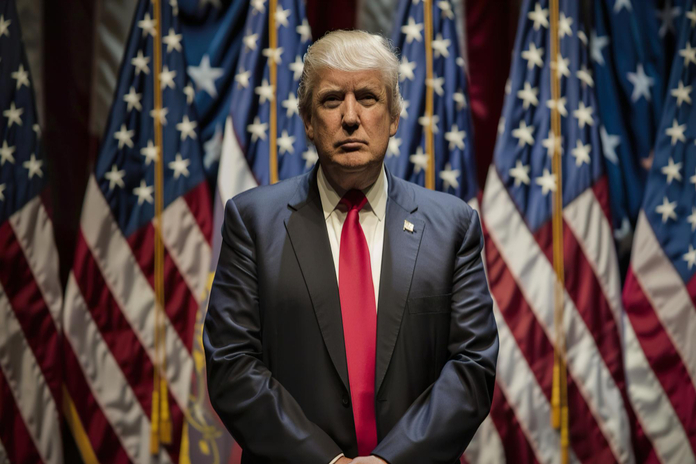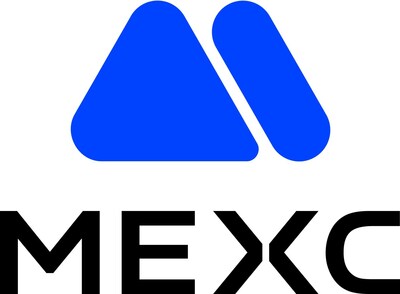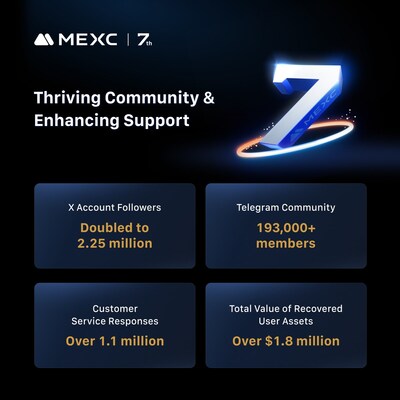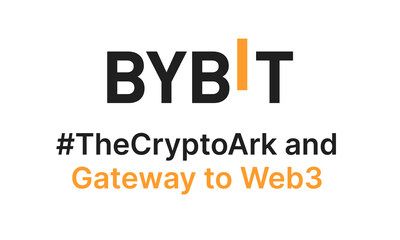This post was originally published on this site
VICTORIA, Seychelles, April 29, 2025 /PRNewswire/ — MEXC, a leading cryptocurrency exchange, witnessed impressive growth throughout 2024, with its global user base soaring to 36 million and trading volumes surging across the board. The platform recorded a 143% increase in Spot trading volume and a 118% jump in Futures trading volume, reflecting its rising dominance in the digital asset space. As MEXC celebrates its 7th anniversary, it has not only weathered the challenges of a highly competitive industry but has firmly positioned itself as one of the top-performing exchanges worldwide—driven by innovation, scalability, and user-first service.
Key Highlights:
- Spot Trading Volume: +143% YoY
- Futures Trading Volume: +118% YoY
- Market Share: Jumped from 2.4% in 2023 to 13.06% in Q1 2025
- User Base: Reached 36 million globally
- Listed Assets: Over 3,000
- Employees: Doubled to 2,000+
- Recovered User Assets: Over $1.8 million
- Customer Service Tickets Resolved: 1.1 million+
Unprecedented Trading Volume Growth: Dominating Market Share
MEXC has demonstrated exceptional performance in its core trading business, with remarkable growth metrics that reflect its increasing dominance in the cryptocurrency exchange landscape. According to the latest data, the platform achieved an impressive 143% growth in Spot trading volume and a substantial 118% increase in Futures trading volume over the past year.
According to TokenInsight’s industry report, MEXC’s market share surged from 2.4% in 2023 to 11.6% in 2024, and further increased to 13.06% in 2025 Q1. The CoinGecko Q1 2025 report also highlighted MEXC’s expanding market presence and growing influence in the global cryptocurrency exchange ecosystem, noting its leap into 3rd place in terms of futures trading volume.
This impressive growth is well above the industry average, showing that more and more traders are choosing MEXC for its strong trading tools. With high liquidity, low fees, and reliable performance in both Spot and Futures markets, the platform continues to attract a wide range of users—from everyday investors to major institutions.
36 Million Users and Counting: MEXC’s Global Expansion
In a testament to its expanding influence, MEXC has witnessed phenomenal user adoption over the past year. The platform welcomed an impressive number of new users, significantly expanding its ecosystem. This substantial influx has propelled the exchange to reach a cumulative user base of 36 million globally.
This rapid growth isn’t just about the numbers—it shows that millions of people and institutions are choosing to trust MEXC for its reliable infrastructure, strong security, and quality service. The platform’s success in gaining and keeping users from around the world highlights its broad appeal and the increasing trust it’s earning from crypto enthusiasts, traders, and investors everywhere.
Strategic Organizational Expansion: Scaling with Purpose
Understanding that technological innovation is driven by human talent, MEXC has undertaken a strategic workforce expansion, nearly doubling its staff to 2,000 employees. This deliberate scaling has focused on strengthening three critical operational pillars:
1. Growth Center – A specialized division dedicated to accelerating user acquisition, enhancing platform adoption strategies, and exploring new market opportunities. This team spearheads MEXC’s expansion into emerging cryptocurrency markets while strengthening its position in established ones.
2. R&D Center – The innovation engine of MEXC, where talented engineers and developers work tirelessly to enhance the platform’s technological infrastructure, develop cutting-edge features, and implement security protocols that safeguard user assets. The R&D team’s commitment to excellence ensures that MEXC remains at the technological vanguard of the crypto exchange landscape.
3. Business Support – The operational backbone ensuring seamless platform functionality, superior customer experience, and efficient business processes. This division works behind the scenes to maintain the high standards of service that users have come to expect from MEXC.
Diverse Asset Offerings with Reward Programs
MEXC continues to enhance its position as a versatile and comprehensive trading platform, offering sophisticated Spot and Futures trading services that cater to both novice and experienced traders. The exchange has significantly expanded its asset portfolio to include an impressive 3,000+ listed assets, providing users with unparalleled diversity in trading options across various cryptocurrencies, tokens, and digital assets. This extensive listing strategy reflects MEXC’s commitment to offering users access to emerging projects and established cryptocurrencies alike, creating a dynamic marketplace where traders can diversify their portfolios and capitalize on market opportunities.
Complementing this diverse asset ecosystem, MEXC has implemented one of the industry’s most comprehensive reward programs, successfully orchestrating 2,293 airdrop events through its innovative token airdrop program, distributing a substantial prize pool valued at $136 million. These strategic initiatives serve multiple purposes: rewarding loyal users, incentivizing platform participation, and introducing the community to promising new projects. By consistently sharing value with its user base while maintaining robust liquidity and advanced trading infrastructure, MEXC has cultivated a culture of reciprocity and mutual growth that strengthens user loyalty and platform advocacy.
Thriving Community: Nurturing Global Connections
MEXC’s vibrant community continues to flourish across multiple social platforms, with its X account followers almost doubling to 2.25 million. This substantial social media presence amplifies the exchange’s voice in cryptocurrency discourse and facilitates direct engagement with users and stakeholders.
Complementing its social media presence, MEXC’s Telegram ecosystem has expanded to include 193,000 members across various groups, creating dynamic spaces for real-time discussions, market insights, educational content, and peer support. These community hubs foster a sense of belonging among users while serving as valuable channels for information dissemination and feedback collection.
The robust growth of MEXC’s community ecosystem reflects the platform’s success in transcending its role as a mere trading venue to become a vibrant hub for cryptocurrency enthusiasts and professionals worldwide.
Customer-Centric Service: Setting Industry Standards
MEXC’s unwavering commitment to customer satisfaction is evidenced by its responsive and resourceful customer service team, which has successfully addressed over 1.1 million customer service requests in the past year. This volume underscores both the scale of MEXC’s operations and its dedication to providing timely assistance to users navigating the complexities of cryptocurrency trading.
Beyond routine support, MEXC’s customer service team has demonstrated exceptional value by helping users recover over $1.8 million in assets that might otherwise have been lost due to user errors, technical issues, or misconceptions. This recovery effort exemplifies MEXC’s proactive approach to customer service and its genuine concern for user welfare beyond transactional relationships.
The quality and effectiveness of MEXC’s customer service infrastructure set new benchmarks for the industry, reinforcing user confidence and contributing significantly to the platform’s reputation for reliability and trustworthiness.
Looking Ahead: Charting the Course for Future Growth
Behind the impressive growth figures lies the comprehensive result of MEXC’s ongoing investment in core trading infrastructure, rapid asset listings, enhanced user experience, and region-specific strategies. MEXC has evolved from its former position as a market follower to establish itself firmly among the world’s elite cryptocurrency trading platforms, demonstrating leadership through innovation and consistent performance excellence.
As MEXC embarks on its eighth year, the exchange stands poised for continued innovation and market leadership. Built on a foundation of user trust, technological excellence, and community engagement, MEXC is strategically positioned to navigate the evolving cryptocurrency landscape.
The impressive metrics across all business areas highlight MEXC’s successful execution of its strategic roadmap and adaptability in a dynamic industry. With its proven track record and clear vision, MEXC remains committed to providing a secure, efficient platform for cryptocurrency enthusiasts worldwide, continuing to shape the future of digital finance.
About MEXC
Founded in 2018, MEXC is committed to being “Your Easiest Way to Crypto.” Serving over 36 million users across 170+ countries, MEXC is known for its broad selection of trending tokens, everyday airdrop opportunities, and low trading fees. Our user-friendly platform is designed to support both new traders and experienced investors, offering secure and efficient access to digital assets. MEXC prioritizes simplicity and innovation, making crypto trading more accessible and rewarding.
MEXC Official Website| X | Telegram |How to Sign Up on MEXC
 View original content to download multimedia:https://www.prnewswire.com/news-releases/from-vision-to-36-million-users-mexc-celebrates-7-years-of-exponential-growth-302440873.html
View original content to download multimedia:https://www.prnewswire.com/news-releases/from-vision-to-36-million-users-mexc-celebrates-7-years-of-exponential-growth-302440873.html
SOURCE MEXC

Featured Image: Pexels @ david mcbee
Disclaimer




























